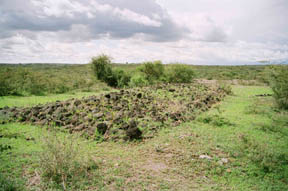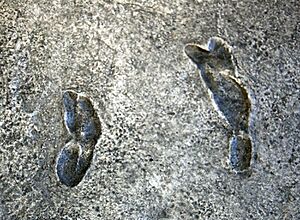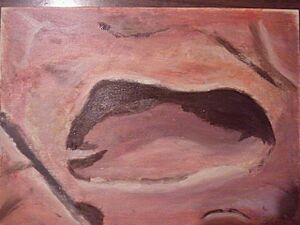Laetoli facts for kids

Laetoli is a very important place in Tanzania, Africa. It is famous for some ancient footprints found there. These footprints were made by early human ancestors, called hominins, about 3.6 million years ago. They were preserved in volcanic ash, which turned into rock over time.
The Laetoli footprint site is about 45 kilometers south of Olduvai Gorge, another famous archaeological spot. Archaeologists Louis Leakey and Mary Leakey found these amazing footprints in 1978. They quickly became famous because they showed that our early ancestors walked upright, just like us! This is called bipedalism.
For a long time, these were the oldest signs of bipedalism. Now, even older evidence has been found, like the Ardipithecus ramidus fossils. But the Laetoli footprints still clearly show that walking upright developed before our ancestors had very large brains. Scientists believe the three individuals who made these footprints were a type of hominin called Australopithecus afarensis. Other animal bones and stone tools were also found at Laetoli.

Contents
Who Made the Laetoli Footprints?
After much study, scientists agreed that Australopithecus afarensis made the Laetoli footprints. This idea came from studying the foot bones of an A. afarensis female. Scientists compared the footprints to how humans and other bipedal animals, like bears and primates, walk.
They looked at things like step length, stride length, and how the foot was angled. The results showed that A. afarensis walked more like a human than an ape. This means A. afarensis always walked on two legs.
How Australopithecus afarensis Walked
Australopithecus afarensis was a hominin that walked upright. Its brain size was similar to modern chimpanzees and gorillas. So, in one way, it was like humans because it walked on two legs. This helped it live in open areas like woodlands and savannahs, not dense rain forests.
However, its brain was still ape-sized. This idea, where different features of an animal evolve at different speeds, is called mosaic evolution. It shows that not all changes happen at the same time.
Footprints in Europe
The oldest hominin footprints found in Europe are in Britain. These footprints are about 800,000 to one million years old. They were discovered on Happisburgh beach in East Anglia.
Archaeologists say these are the "oldest known hominin footprint surface outside Africa." The area is known for preserving ancient sediments with early Pleistocene animals and plants. Since 2005, flint tools have also been found there. This means humans lived in northern Europe at least 350,000 years earlier than previously thought.
Images for kids
See also
 In Spanish: Laetoli para niños
In Spanish: Laetoli para niños






